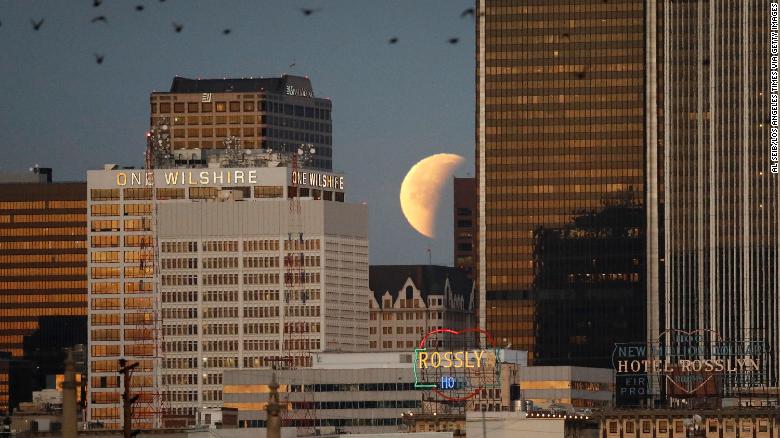Iron: An object could hit the Earth in 2124 1:12
(CNN) -
Total lunar eclipses, multiple meteor showers and supermoons will light up the sky in 2022.
The new year will be a wonder for sky watchers, with many astronomical events on the calendar.
There is always the possibility that the International Space Station will fly overhead.
And if you want to know which planets are visible in the morning or afternoon sky, check out The Old Farmer's Almanac's guide to visible planets.
These are the main celestial events of 2022 so that you have your binoculars and your telescope ready.
Full moons and super moons
This image, taken in Brazil, shows a plane passing in front of the March 2020 supermoon.
There are 12 full moons in 2022, and two of them qualify as super moons.
advertising
Definitions of a supermoon can vary, but the term generally denotes a full moon that is brighter and closer to Earth than normal and therefore appears larger in the night sky.
Look at the difference in size between an average full moon and a supermoon
Some astronomers claim that the phenomenon occurs when the Moon is at 90% perigee, which is its closest approach to Earth in orbit.
By this definition, both the June full moon and the July full moon are considered supermoon events.
Here's the list of full moons for 2022, according to the Farmers' Almanac:
January 17: Wolf Moon
February 16: Snow Moon
March 18: Worm Moon
April 16: Pink Moon
May 16: flower moon
June 14: Strawberry Moon
July 13: Deer Moon
August 11: Sturgeon Moon
September 10: Harvest Moon
October 9: Hunter's Moon
November 8: Beaver Moon
December 7: Cold Moon
Although these are the popularized names associated with the monthly full moon, each of them has a varied meaning in Native American tribes.
Lunar and solar eclipses
Watch the total solar eclipse that left a strange darkness in Antarctica 1:00
In 2022 there will be two total lunar eclipses and two partial solar eclipses, according to The Old Farmer's Almanac.
Partial solar eclipses occur when the Moon passes in front of the Sun, but only blocks part of its light.
Make sure you wear the right glasses to view solar eclipses safely, as sunlight can be harmful to your eyes.
A partial solar eclipse on April 30 can be seen by those in southern South America, the southeastern Pacific Ocean and the Antarctic Peninsula.
Another, on October 25, will be visible to residents of Greenland, Iceland, Europe, Northeast Africa, the Middle East, western Asia, India and western China.
Neither of the two partial eclipses of the sun will be visible from North America.
A lunar eclipse can only occur during a full moon, when the Sun, Earth, and Moon align and the Moon passes into the Earth's shadow.
The Earth casts two shadows on the Moon during the eclipse.
The penumbra is the partial outer shadow, and the umbra is the full, dark shadow.
What is a lunar eclipse, what types are there and other information you should know
A photographer captured this image of a "blood moon" in Los Angeles in January 2018. (Credit: Al Seib / Los Angeles Times)
When the full moon enters the Earth's shadow, it darkens, but does not disappear.
Sunlight streaming through Earth's atmosphere dramatically illuminates the Moon, turning it red, which is why it is often referred to as a "blood moon."
Depending on the weather conditions in your area, it can be rust, brick, or blood red.
This happens because blue light suffers greater atmospheric scattering, so red light will be the most dominant color that stands out when sunlight passes through our atmosphere and projects it onto the Moon.
A total lunar eclipse will be visible to the inhabitants of Europe, Africa, South America and North America (excluding the Northwest regions) between 9:31 PM (Miami time) on May 15 and 2:52 AM on May 16.
Another total lunar eclipse will also be visible to those in Asia, Australia, the Pacific, South America, and North America on November 8 between 3:01 a.m. ET and 8:58 a.m. ET, but the Moon will hide for those around it. in the eastern regions of North America.
Meteor showers
The new year begins with the Quadrantid meteor shower, which is expected to peak in the night hours between January 2-3 for North Americans, according to the American Meteor Society.
The Perseid meteor shower, which occurs every year in August, is a real wonder for sky watchers as it casts many streaks of light through our atmosphere.
It is the first of 12 meteor showers that will occur throughout the year, although the next, the Lyrid meteor shower, does not reach its maximum until April.
Here are the other meteor showers to watch out for in 2022:
Lyrids: April 21 and 22
Eta Aquarids: May 4-5
Southern Aquarids Delta: July 29-30
Alpha Capricorns: July 30-31
Perseids: August 11-12
Orionids: October 20-21
Southern Taurids: November 4-5
Northern Taurids: November 11-12
Leonidas: November 17-18
Geminids: December 13-14
Ursidas: December 21-22
If you live in an urban area, it is recommended that you go to a place that is not riddled with city lights that obstruct your vision.
If you find an area that is not affected by light pollution, meteors could be visible every two minutes from dusk to dawn.
Find an open area with a wide view of the sky.
Make sure you have a chair or blanket so you can look up.
And give your eyes 20-30 minutes to adjust to the dark - without looking at the phone - so meteors are easier to spot.
Lunar eclipsereclipsesastronomical eventsmeteor showerfull moon

